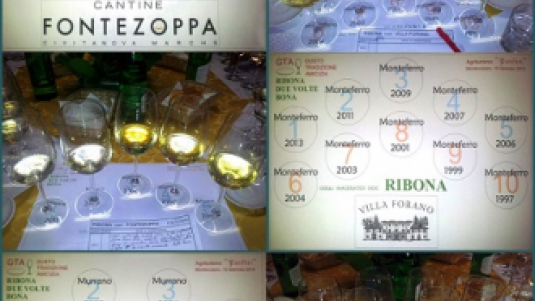Palmiro and Ribona

Palmiro Ciccarelli is passionate about where he is from and everything the southern area of the Marche regions produces: wines, olive oils, farm produce and wild game. In fact, all his free time is dedicated to promoting these products, without any reservations. Over the years he has become such a point of reference for them that, I think, producers should erect a statue in his honor. If every part of Italy had their own Palmiro, the awareness of the country’s wonderful products would be much greater.
Last January, he invited me for the first time to a lavish feast of wild game which he had prepared in every minute detail. I did not have to pay because he had paired the meal with a tasting of 23 bottles of Colli Maceratesi white wine which, being made with over 85% Maceratino grapes, qualified as Ribona (otherwise they are just a ‘Bianco’). The Maceratino grape is cultivated in around 100 hectares of land in the province of Macerata and around the town of Loreto. For a long time it was thought to be identical to Greco, the famous variety from the southern Campania region, but recent tests have verified that it is, in fact, a distant cousin to the Trebbiano and Verdicchio grapes, even if it is quite different from them. The other grapes that can be blended with Ribona are: Incrocio Bruni, Grechetto, Trebbiano Toscano, Verdicchio, Chardonnay, Sauvignon and Malvasia Bianca Lunga.
Here we will not review all the wines tasted, only the ones we thought were the best or most interesting. All were made with only Maceratino grapes, in line with a trend to highlight the typicality of local products.
The 23 Ribona wines included a complete vertical tasting of three estates: Villa Forano, Capinera and Fonte Zoppa. The oldest was a 1997 and the quality of the wines fluctuated significantly, demonstrating that this grape is still difficult to understand and interpret correctly. The grape does not adapt well to any terroir away from its natural habitat where the soil is not that fertile, temperatures are moderately high and there are light breezes. The vines blossom late and this helps to avoid any damage from spring frosts. The grape ripens in the second half of September and needs special care in the vineyard and, since it is easily subjected to reduction, even more attention in the winery.
Should you find this article to be rich in content and interesting aspects, the merit can only go to Palmiro Ciccarelli and his immense and unbridled passion.

 Italiano
Italiano












